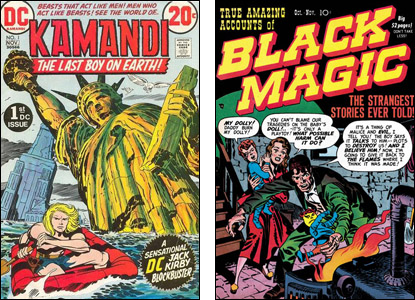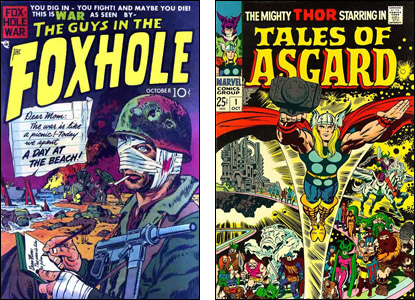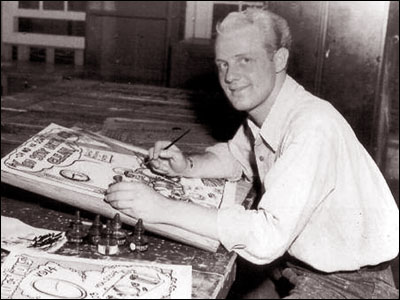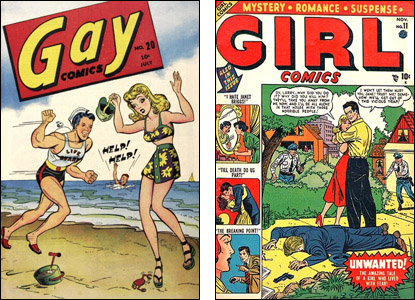
I get a lot of questions in my e-mail about comics and movies and cartoons and other aberrant topics that folks think I know something about. But I get more questions about Kirby than any five other topics combined. Here's some of what gets asked and how it's answered. If you have a query not covered below, send it in and we'll try to get to it, if not here then in the pages of The Jack Kirby Collector, a fine periodical to which you're already subscribed if you have any interest in the man.

Who did what on the Lee-Kirby collaborations?
Ooh…tough one to start with. Well, it's safe to say Jack did all the penciling. Beyond that, we run into all sorts of semantic arguments having to do with definitions of the word "writing" and with the fact that Mssrs. Lee and Kirby both have / had notoriously poor memories. You also have the fact that when two creative talents get together and come up with an idea, each of them might honestly believe that he suggested at least the core of the concept if not the entire thing. This happens in any collaboration anywhere and, ultimately, you usually have to just say that they both had the idea. Ergo, I say that the Lee-Kirby creations are Lee-Kirby creations.
Some of the ideas sound more like Stan to me, some sound more like Jack and there's some documentation and other evidence that suggests that certain ideas flowed more from one gent than the other. Even then, even where one person contributed 80% of the notion, they are still Lee-Kirby co-creations. The plots came from both, though Stan has acknowledged that once Marvel started to grow and he became busier, Jack was largely on his own to figure out the details of each story, if not the basic plotline. Stan's dialogue sometimes closely paraphrased marginal notes that Jack wrote while drawing, and sometimes deviated altogether. I do think Stan has been unfairly maligned by those who've said that all he did was retype and polish Jack's notations. I also think Jack was wronged by credits that gave him no credit for anything other than drawing because he certainly did more than that.
None of this is meant to suggest I view it as a 50/50 collaboration. Even looking just at the concepts and storylines, I think Jack contributed a lot more to them than Stan did.
Didn't Kirby contribute the cosmic concepts and Lee contribute the human elements?
You might think that. Once upon a time, I did, as well. But after talking extensively with both Stan and Jack, as well as some of their co-workers…and after examining a lot of Stan Lee plot outlines and Jack Kirby marginal notes, my conclusion is that that wasn't always the case. Stan definitely contributed some of the more "cosmic" (for want of a better adjective) ideas and Jack certainly contributed some of the elements we might call "soap opera." There are specific contributions that I believe can be attributed to one or the other, at least in that one of them was the primary source. But, as stated above, there's a point beyond which one cannot tell who did what.
What was Jack Kirby like?
Jack was a very sweet man with a heart as large as his imagination — and if you read anything he ever did, you at least know how large his imagination could be. He had a tendency to assume the best about everyone he met and to be angry later-on when, as occasionally happened, someone turned out to be undeserving of his trust and friendship. There were a few folks who — in my opinion — exploited his generosity far beyond decency…in some cases, quite without malice or even awareness of their impact on his life. In any case, he was an enormous supporter of New Talent. If you showed Jack your work, he would not give you an art critique — he didn't do that kind of thing — but he would give you words of encouragement, along with pointers of a "spiritual" sense, discussing the mindset with which you should approach your work. And he would never, no matter how poor your work was, tell you to give up.
Was Jack really as fast as they say?
Yes, but I think his pace gets exaggerated a bit for two reasons. One was that Jack worked very hard. During the late sixties and seventies, he did around fifteen pages per week of finished pencils (and, usually, script) and before that, he was even more prolific, occasionally managing 5-6 pages a day. Now, that is very fast — someone like Curt Swan might do two a day — but Kirby's output was a function not just of drawing speed but of endurance and a willingness to sit at the drawing board 10-16 hours a day. Some artists simply couldn't put in hours like that. And the other thing that perhaps made Jack appear faster than he was was that he did almost no planning. This is why you see very few Kirby rough sketches around. If they called Jack and said, "We need a cover," he would just sit down and start drawing a cover. Some of his best work was done with that kind of instant improvisation. But, yes, he was fast.
What was Jack's favorite kind of comic to work on?
He really didn't have one, at least in terms of subject matter. He — of course — wanted to do comics that he felt would sell well and, at varying intervals, he felt that the time was right for a a specific genre or kind of story. He also — of course — wanted to do work where he felt he was in control of the story and allowed to do his work with a minimum of interference and (relatively) fair compensation, and he generally didn't like doing strips that he felt were someone else's; where he was obliterating another creator's vision by imposing his. But beyond all those caveats, he was just as happy drawing a monster comic as a super-hero adventure; just as contented to do a romance comic as a science-fiction or western title. In fact, I think he took a special pride in being able to build something out of any kind of materials.
The one genre he probably enjoyed a little less than any other was the kind of "ghost" comics that dwell on death. On the other hand, if he enjoyed any area a bit more than others, it would be the occasions when he had the chance to draw tales set in World War II and to tap into his limitless storehouse of anecdotes from his combat days. His days writing and drawing "The Losers" for Our Fighting Forces were fun for him, marred only by the fact that the characters were not his, nor were they characters that particularly interested him. I also believe that late in his career, Jack wished he'd had more opportunity to draw funny material in a broader style.
I've heard Jack modeled a lot of his characters on real people. If so, who was Big Barda based on?
Jack based some of his characters (not all) on people in his life or in the news…though often, the connection would be lost as the character evolved. That is to say, once the story was done, only Jack would be able to see any trace of the model…and sometimes, even he would lose track of how a character came about. Nevertheless, Big Barda's roots are not in doubt. The visual came about shortly after songstress Lainie Kazan posed for Playboy…and the characterization between Scott "Mr. Miracle" Free and Barda was based largely — though with tongue in cheek — on the interplay betwixt Jack and his wife Roz. Of course, the whole "escape artist" theme was inspired by an earlier career of writer-artist Jim Steranko.
Apart from Sandman #1 in 1974, was The Fly (1959) the last Simon-Kirby collaboration?
The Fly was the last published work by Joe Simon and Jack Kirby, excepting that Sandman comic and some leftover material done before The Fly but published later. However, The Fly was not a product of the Simon-Kirby shop in the same way comics like Black Magic and Boys' Ranch had been. The Fly was a product of Joe Simon who, in turn, hired Jack to do some of the artwork. (Jack claimed he did all his work for the first two issues over one weekend. That's probably not true but he didn't spend a lot more time than that. Some of what appears to be Kirby in those issues and #3 and #4 is, in fact, a case of Jack's work being imitated by someone else.)
What other comic book artists did Jack admire?
Practically all his contemporaries…but if you asked him, the first names out of his mouth were usually Bill Everett, Wally Wood, Steve Ditko, Joe Simon, Don Heck, Gil Kane, Gene Colan, Lou Fine, Jack Cole, Dick Briefer, Joe Kubert, Alex Toth, John Romita, Jim Steranko, C.C. Beck, George Tuska, Joe Shuster, Mort Meskin, Marie Severin, John Severin, Al Williamson, Dick Ayers, Joe Maneely, Jack Davis, Sergio Aragonés and many others I'm leaving out. He also loved most of the great newspaper strip artists, including Milton Caniff, Alex Raymond, Hal Foster, Al Capp, Walt Kelly, Elzie Segar, Frank Robbins, Will Gould and Roy Crane. Frankly, I can't think of too many artists of whom Jack ever spoke in negative terms.
What kind of pencil and paper did Jack use?
Pencils were your basic #2 drawing pencil, although he sometimes experimented with softer leads. As for paper, Marvel and DC both supplied paper most of the time. Jack found the Marvel paper easy to draw on and most of the DC paper impossible to draw on. He got into a friendly argument once with Joe Kubert, who loved the DC paper. Kubert told Jack it worked great if you pencilled in blue. Jack said he hated working in blue pencil. Kubert said it took a brush well. Jack said, "I don't ink." And so on. Steve Sherman and I finally bought Jack a kind of two-ply kid-finish Bristol Board that he liked and that was fine until Mike Royer started inking the books, and Mike had enormous problems inking on the paper. So a lot of time was spent trying different kinds before we found one that Jack could pencil on and Mike could ink on…and I don't recall the name of the brand. But this explains why comic book companies usually furnish the paper for their artists to draw on. It cuts down on arguments between pencillers and inkers.
What were Jack's politics like?
He was a rather liberal democrat — not uncommon among Jewish folks of his generation — but he had a general suspicion of most leaders of all stripes. He admired Adlai Stevenson and John F. Kennedy, but not many prominent politicians of any party beyond those two. He was especially distrustful of public figures about whom there was a "cult of personality," and he used those feelings when he wrote about Glorious Godfrey in the Fourth World series. Godfrey was inspired by the then-current pronouncements of the Reverend Billy Graham (and a wee bit by TV pitchman Arthur Godfrey). Mr. Graham's speeches now seem more subdued but, at the time, he was coming under criticism from all sides for what some felt were excessive, apocalyptic speeches predicting the end of the world. Jack saw a few of Graham's fire-and-brimstone lectures on TV and felt that the reverend was abusing his position by taking the "fear" in "fear of God" to unhealthy extremes.
And he really, really didn't like Richard Nixon.







